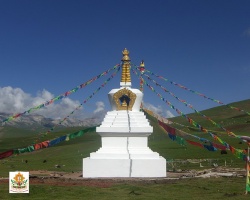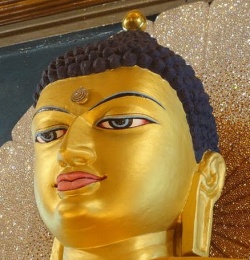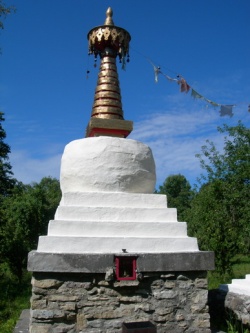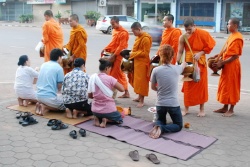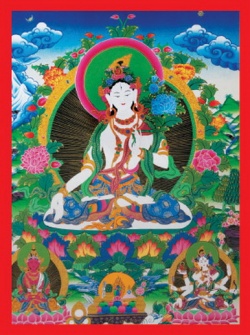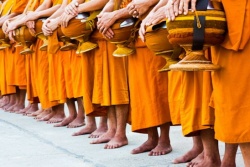The Great Exposition of Secret Mantra
The Great Exposition of Secret Mantra, The Stages of The Path to a Conqueror and Pervasive Master, a Great Vajradhara: Revealing All Secret Topics, by Tsongkapa(1357-1419), founder of the Gelugpa order of Tibetan Buddhism.
Translated by Jeffrey Hopkins
Associate Editors: His Holiness, The 101th Ganden Tripa, Lati Rinpoche; Geshe Gedun Lodro
One Goal
through the paths have differences,
their fruits do not differ as to superiority and inferiority
Actual meaning of all the different paths'
not having different fruits
(the below is a debate whereby an opponent put forward a question or challenge, the master answers or refute the points presented)
Objection: if the paths of the two vehicles have superiority and inferiority, then so do their objects of attainment---buddhahood. for, if the causes differ, it would be contradictory if the effects did not; otherwise, the difference in causes would be senseless.
therefore, the 11th ground of complete light is lower than that of vajradhara. the 4th chapter of the first division of the samputa tantra says:
in brief the buddhahood
achieved over countless
or ten million aeons
u will attain in this birth
through the most excellent bliss,
or (the ground of) vajradhara
this text explains that buddhahood, which is attained over 10 million or countless aeons, and vajradharahood are different. those who have not attained the inconceivable states are tathagatas, buddhas. to illustrate what is to be illustrated(that is, the one who attains the inconceivable state) he is called (vajra) sattva.
Answer: ( your interpretation) is not correct. this passage does not teach that through the path of the highest yoga, one achieves in a single life either the ground of complete light which is set forth in the perfection vehicle or the ground of vajradhara which is set forth in the mantra. also, not even those of the perfection vehicle assert that there is no difference between ( the 10th bodhisattva ground called)"buddha" which is attained over countless aeons and the the 11th of complete light. for there are 2 types of attainment over countless aeons; one is a "buddha" who is a 10th ground bodhisattva called a buddha(whereas the other is an actual buddha of the 11th ground).
maitreya's ornament for the realisations says:
having passed beyond the 9th ground, the wisdom
by which one abides on the ground of a buddha
is to be known as the 10th
ground of a bodhisattva
Answer (cont'd): the vajradhara ground(actual buddhahood) is the 11th ground. though there are explanations in mantra of 12th, 13th and 14th grounds, indian scholars have explained them as divisions of those in the perfection vehicle. i will explain this later when dealing with the fruit(at the of the section on highest yoga tantra)
u should know that the 11th ground of complete light and vajradhara are the same.
that in the sets of sutras it can be achieved over 3 countless aeons, and in the sets of tantra in one lifetime. u should not hold that because it is called vajradhara, it is not a fruit of the perfection vehicle
shantirakshita's text on the establishment of the principles(tattvasiddhinamaprakarana) says:" the glorious great bliss, vajrasattva--the object of realisation by other paths over many countless aeons-- is achieved without difficulty in this lifetime itself by those who possess the method of the vajra vehicle."
thus the glorious shantirakshita says that vajradharahood is the object of attainment for both path.
also, abhayakara's commentery on the passage from the samputa tantra( pg 139) in his clusters of quint-essential instructions says," "buddha" refers to a lord of the 10th ground."high buddha" is the attainment of a special path. "vajradhara" refers to a lord of the 11th ground."
tripitakamala's lamp for the three modes says:
"
though the object is the same, mantra treaties
are superior because of being for the non-obscured,
having many skillful methods, no difficulties, and
being contrived for those with sharp faculties."
the objector himself asserts that this means that the object of attainment of the mantra and perfection vehicle is the same.
Answer (cont'd): furthermore, the perfection vehicle explains that one who has attained the ground of complete light has abandoned the 2 obstructions along with their predisposing latencies and has attained all buddha attributes such as the powers, fearlessness and unshared qualities. if there were something superior to the buddhahood explained in the perfection vehicle, one would have assert that although the 2 obstructions were removed along with their predisposing latencies, there would still be defects to remove.
one would have to accept that although the 144 uncontaminated qualities, such as the 10 powers, had been attained, one would still not have completed the auspicious attributes. therefore it is suitable to analyse-- as many indian scholars have-- whether, without depending on the mantra path, one can or cannot proceed to such a state using only the paths explained in the perfection vevicle; however, it is wrong to assert that one can progress to the ground of complete light by the perfection path alone but that still one has to progress higher
the modes of progress on the perfection and mantra paths differ as to inferiority and superiority in the sense that on the former one cannot and on the latter one can become fully enlightened without relying on countless aeons (of practice). however, this does not cause the fruits to be differ in quality. this in turn is no proof, however, that the difference in causes is purposeless because, even though the fruits do not differ in quality, they do so greatly in terms of how distant or close they are
difference between the perfection and mantra paths
the difference in speed between the 3 lower tantras and the perfection vehicle is that (in the path of the 3 lower tantras) the practice of enlightenment are completed through many common achievements depending on the powers of deity yoga and repetition, and although many skillful means such as being directly substained and empowered by buddhas and great bodhisattvas. the difference in speed in highest yoga tantra is that even the stage of generation has many profound essentials missing in the lower sets of tantras while the completion has supreme profound essentials.
a difference in speed due to the development of full enlightenment without relying on the passage of countless aeons is a distinguishing feature of highest yoga tantra. such attainment by the trainees of the lower sets of tantras attained by the trainees of the lower sets of tantras depends on their entering into the two stages of highest yoga; their own path alone are not sufficient.
thus it should not be held that all differences of speed in mantra are only due to the development of full enlightenment in one life in this degeneration age or to the development of full enlightenment without relying on countless aeons( of practice)... therefore we do need countless aeons of practice as well, to have the karma of practicing mantrayana:)
with the above topic of "one goal", it explains the question brought up in my other thread "Non-sectarianism?"
quintessential points on the difference between theravada and mahayana; and the 2 mahayana(i.e. perfection and mantra vehicle)
by his holiness the 14th dalai lama
1) the dalai lama teaches that one needs to combine learnedness, practical application, and a good mind. therefore, mere learnedness about the difference between the vehicles is not sufficient.
2) generation of a good mind is the essential puropose of differentiating the vehicle; the immediate purpose is to know the difference between the vehicles in order to facilitate practice.
theravada and mahayana
3) one can distinguish the term "theravada" and "mahayana" from the view point of schools of tenets and from the viewpoint of path
4) one can be a mahayanist by tenent and a theravadan by path, as in the case of the great foe destroyer of the past. thus, there are some who are capable of assuming a mahayana tenet system who are temporarily incapable of generating a mahayana path.
5) the 2 theravada tenet system(vaibhashika and sautrantika) and the 2 mahayana tenet system( chittamantra and madhyamika) each present a theravada path( hearer and solitary realiser paths) and a mahayana path(bodhisattva path)
6) the reason for 4 schools of tenets is persons' differing capacities, including the pride of wanting the highest despite being incapable of it; thus lower, non-final systems are taught as if they are final.
7) the difference between theravada and mahayana and between the 2 mahayanas must be found in the sense of vehicle as that to which one progresses( the fruit) and/or as that by which one progresses(method, wisdom, or both)
8) valid foundation and the conditionable nature of the mind makes limitless development of method and wisdom possible
9) the difference between theravada and mahayana lies in the sense of vehicle as that to which one is progressing (i.e level of bodhicitta)) and as those practice by which one progresses (specifically the method, not wisdom)
10) from the view point of prasangika-madyamika, the wisdom of both vehicles is the same because the root of cyclic existence is the concept of person and other phenomena as inherently existent, and foe destroyers( those who have attained the fruit of the theravada paths) are liberated from cyclic existence(samsara), having destroyed the foe of afflictive ignorance.
11) therefore, both theravada and mahayana paths involve realisation of the subtle emptiness which is the lack of inherent existence in person and other phenomena.
12) therefore, the difference between theravada and mahayana in terms of vehicle lies not in wisdom but in method--motivation and its attendant deeds. the theravada motivation focus more on the individual while the mahayana motivation focus on all sentient beings.
13) there are 2 kinds of obstructions: afflictive(i.e. preventing liberation from samsara) and obstruction to omniscience (i.e. preventing the simultaneous cognition of the 2 truths--ultimate truth and conventional truth)
14) the afflictive obstructions are (i) the ignorance conceiving the inherent existence of person and other phenomena, (ii) the other afflictions which this induces, and (iii) their seeds
i may be unable to continue sharing on a regular basis here due to my new work comittments.
i will only do so if time permits but i think it would be quite difficult.
i would like to thank all those who enjoys my sharing and my stay here has been a nice one. this place has been my new home since the destruction of esangha forum, which i was from formerly.
as the scripture says:
"
All compnents things disintegrate
What rises must fall
All meetings end in separation
What is born must die."
just as i have come to this forum from the esangha forum due to the site being hacked and had been down since, this shows that everything is illusionary and impermanent.
may all be a lamp upon themselves and may the buddha dharma shine forth like the sun in this dark era.
amituofo!
15) obstructions to omiscience are predispositions which are established by the conception of inherent existence but which produce thefalse appearance of inherent existence as well as the incapacity to cognise the 2 truths(Conventional Truth (Sammuti Sacca) and Ultimate Truth (Paramattha Sacca) ) directly and simultaeously
16) if one's aim is merely to abandon the afflictive obstructions, it is sufficient to approach emptiness through merely a few forms of reasoning.
if one's aim is to eradicate obstructions to omniscience and thereby attain buddhahood, it is necessary to approach emptiness through limitmess form of reasoning.
17) thus, although there is no difference in the type of wisdom between theravada and mahayana, there is a difference in the mode of cultivation and the eventual effect.
Theravada Path
1) path of accumulation
2) Path of preparation
3) Path of seeing
4) Path of meditation
5) Path of no more learning (Foe destroyer)
Mahayana Path
1) path of accumulation
2) path of preparation
3) path of seeing: first ground
4) path of meditation: second ground to tenth ground
5) path of no more learning: eleventh ground (Buddha)
Note: while a bodhisattva at effect stage is call a buddha whereas the others (following the theravada path) are known as foe destroyers i.e those who have destroyed the foe of afflictions, mainly desire, hatred and ignorance--because Buddha has special knowledge, more subtle clairvoyance, and a distinctive body.
difference between perfection vehicle and mantra vehicle (note: both belongs to mahayana)
1) the 2 mahayanas, perfection vehicle and mantra vehicle, have the same fruit and the same wisdom; therefore, the difference lies in method, which is tantra's special feature of deity yoga
2) a pratitioner of tantra must have particularly intense compassion, being in great haste to become a Buddha in order to help others
3) method in perfection vehicle and mantra vehicle is the same with respect to the basis of practice, which is the altruistic mind of enlightenment(bodhicitta), and the deeds of practice, which are the 6 perfections. therefore mantra vehicle does not discard or transcend the conventional mind of enlightenment, i.e. the altruist aspiration to Buddhahood for the sake of others and the bodhisattva deeds; as well as the ultimate mind of enlightenment i.e. the direct realisation of emptiness by a bodhisattva. however, mantra has the additional feature of deity yoga
4) the difference in speed between between the 2 mahayanas is due to a faster accumulation of merit in the mantra vehicle( if one is capable of practising it) , resulting from the cultivation of deity yoga. this involves meditiation cultivating a similitude of a buddha's form body, residence, resources and activities.
5) emptiness yoga is a general feature of a buddhist deity yoga, differentiating it from non-buddhist deity yoga.
6) in emptiness yoga, one must confidently stabilise on the vacuity ( i.e. changing mind) which is a negative of inherent existence found after searching for a concretely existent self which so clearly appears to us.
7) deity yoga involves causing the mind realising emptiness and fused with that emptiness to itself appear as a deity, out of compassion, in order to help others.
8) "vajra" means an indivisible union of the wisdom realising emptiness and compassion
9) the perfection vehicle does not have deity yoga even though it has meditiation cultivating a similitude of the truth body i.e. the space-like meditative equipoise on emptiness.
10) all tantric practices are either deity yoga, emptiness yoga, or enhancers of these two
11) the perfection alone is not sufficient for the attainment of buddhahood, nor are the three lower tantras alone. hightest yoga tantra is required for overcoming the extremely subtle obstructions to omniscience.
12) for tantra in general, the difference in speed over the perfection vehicle is the passage from the beginning of the path of accumulation to the path of seeing faster than the one period of countless aeons required in the perfection vehicle.
13) the attainment of buddhahood in one lifetime is a distinctive feature of highest yoga tantra.
14) because the practices of the perfection vehicle are indispensible to and the very substance of the mantra vehicle, we should view its ancillary (i.e. useful) practices, such as that of impermanence which is condusive to realising emptiness, as substantial contributors to the mantra path
